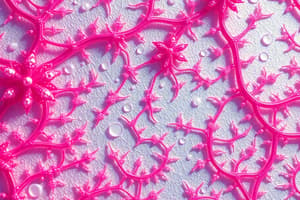Podcast
Questions and Answers
Which type of tissue is responsible for holding other tissues together and facilitating communication between them?
Which type of tissue is responsible for holding other tissues together and facilitating communication between them?
- Muscle tissue
- Connective tissue (correct)
- Nervous tissue
- Epithelial tissue
What is the main function of epithelial tissue in the body?
What is the main function of epithelial tissue in the body?
- Acting as a barrier and nutrient transport pathway (correct)
- Producing movement in the body
- Transmitting information throughout the nervous system
- Holding tissues together
How is muscle tissue classified based on its location and function?
How is muscle tissue classified based on its location and function?
- By its location in the body and function (correct)
- By its ability to produce movement
- By its role in nutrient transport
- By its function in supporting other tissues
Which type of tissue protects against foreign invaders while allowing nutrients to pass through?
Which type of tissue protects against foreign invaders while allowing nutrients to pass through?
In animals, what is the main function of nervous tissue?
In animals, what is the main function of nervous tissue?
What is the main function of loose connective tissue?
What is the main function of loose connective tissue?
Which type of tissue features parallel arrays of collagen fibers and is responsible for linking muscle to bone?
Which type of tissue features parallel arrays of collagen fibers and is responsible for linking muscle to bone?
What is the main function of adipose tissue?
What is the main function of adipose tissue?
Which type of epithelial tissue is found in the skin?
Which type of epithelial tissue is found in the skin?
What aspect of tissues do histologists examine under the microscope to differentiate distinct tissue types?
What aspect of tissues do histologists examine under the microscope to differentiate distinct tissue types?
Study Notes
Understanding Tissues: Building Blocks of Living Organisms
In our human bodies, a diverse array of tissues forms the foundation of life's complexity, enabling us to perform everyday tasks from breathing to digesting food. To delve into this fascinating realm, we'll explore various aspects of tissues – their classifications, roles, microscopic structures, and specialized examples like connective and epithelial tissue.
Types of Tissues
Tissues, often likened to brickwork in buildings, are collections of similar cells organized together to carry out specific functions. There are four main categories of tissues within animals:
- Epithelial tissue: Found lining body surfaces, organs, and cavities; acts both as a barrier and nutrient transport pathway.
- Connective tissue: Holds other tissues together, provides support, and facilitates communication between them.
- Muscle tissue: Produces movement by contracting and relaxing; classified as skeletal, smooth, or cardiac based on location and function.
- Nervous tissue: Forms nerve cells called neurons, transmitting information throughout the nervous system.
Functions of Tissues
Each type of tissue performs unique, yet interdependent, duties, forming the harmony essential for healthy organism functioning. For example, epithelial cells protect against foreign invaders while also allowing nutrients to pass through. Meanwhile, connective tissue binds muscles, bones, blood vessels, and organs, serving structural purposes such as maintaining proper positioning.
Histology
To better visualize tissues under the microscope, histologists examine cellular organization, arrangement, size, shape, and staining patterns to identify and differentiate distinct tissue types. This discipline is crucial because it provides valuable insights into cell behavior during development, injury repair, disease progression, and other biological processes under study.
Connective Tissue
This category has numerous subtypes, each with its own characteristics and functions:
- Loose connective tissue contains collagen fibers, proteoglycans, and elastic fibers, providing flexibility to maintain tissue integrity without impeding growth and expansion. Examples include fatty tissue (adipose) and loose areolar tissue found around blood vessels and nerves.
- Dense irregular connective tissue consists primarily of collagen fibers densely packed around cells in a non-uniform manner, offering strength to resist stresses. Anchoring fibrils anchor tendon fibers to bone via dense irregular connective tissue.
- Dense regular connective tissue features parallel arrays of collagen fibers, granting superior tensile strength and stiffness to form ligaments, tendons, and aponeuroses. These elements link muscle to bone and enable force transmission.
- Adipose tissue stores energy (lipids) and insulates the body against temperature changes. White and brown adipocytes store lipids differently and have variable metabolic properties.
Epithelial Tissue
Consisting mostly of epithelial cells arranged to create protective barriers, this tissue covers external surfaces, lines internal spaces, and forms glands producing secretions essential to survival. Some common epithelium types include simple squamous (e.g., alveoli), stratified squamous (e.g., skin), cuboidal (e.g., kidney tubules), columnar (e.g., intestinal mucosa), ciliated pseudostratified columnar (e.g., respiratory tract), and transitional (urinary bladder).
Understanding these fundamental concepts will help you appreciate how our bodies are more than simply sums of individual cells, but rather complex systems built upon coordinated actions of intricate cellular arrangements. So whether you're studying biology, medicine, or just curious about your surroundings, pondering the design principles underlying tissues can reveal extraordinary secrets hiding within living things' simplest building blocks.
Studying That Suits You
Use AI to generate personalized quizzes and flashcards to suit your learning preferences.
Description
Explore the diverse world of tissues, the building blocks of living organisms, and learn about their classifications, roles, microscopic structures, and specialized examples such as connective and epithelial tissue. Dive into the functions of different tissues and the crucial field of histology that helps us understand cellular organization and behavior.




